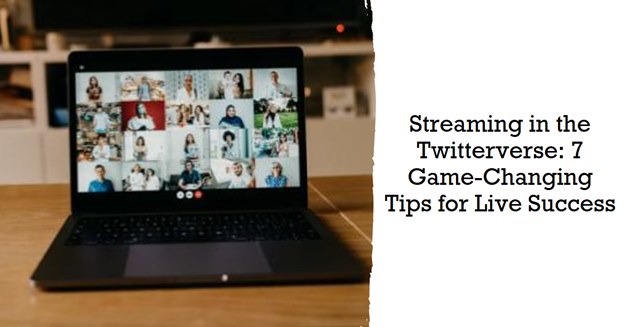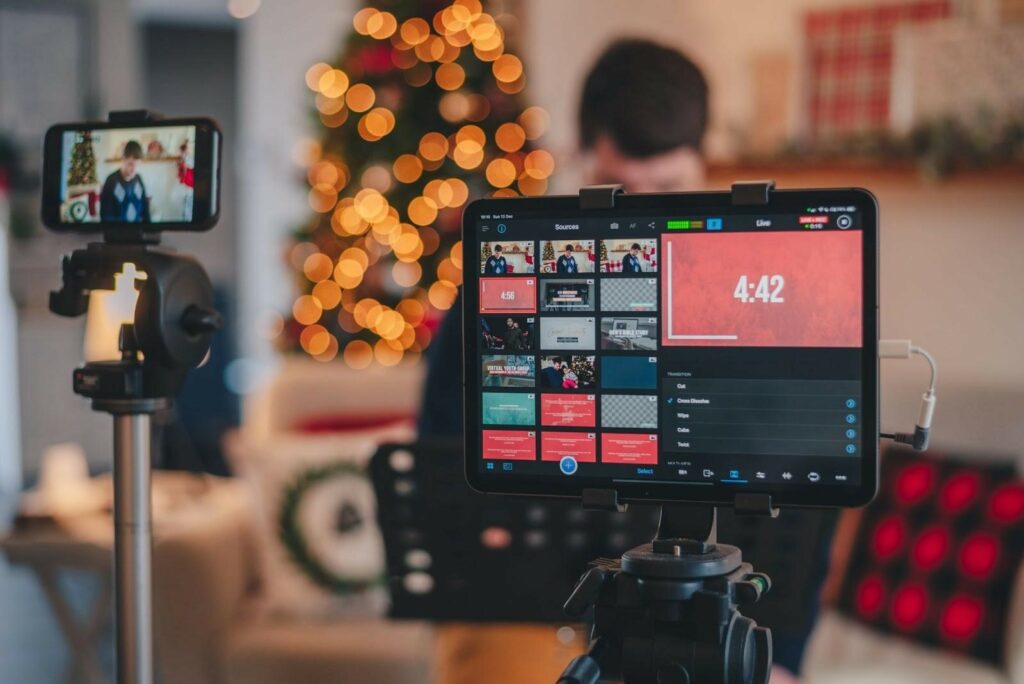
Twitter live streams have only improved with time and have become quite sophisticated. The process involving setting up a live stream, however, isn’t that complicated. Despite that, not every Twitter livestream achieves the same level of success; only the few that hit the right buttons do.
A lot has changed on Twitter, especially the quality of its services. The platform’s new acquisition recently pushed for a rebrand to the highly publicized but relatively controversial name, X. Despite such colossal changes, its growth trajectory has increased with more people joining it.
In 2021, the Twitter engineering team said they processed over 400 billion events in real-time. That shows how much of a beehive this platform has been from the onset. With its increased popularity, more people are signing up, and the number of live streams is steadily increasing. This article is for anyone who seeks to succeed with Twitter live streams and provides seven clever tips that may guarantee that.

Set Up Your Goals
Setting your goals is essential before you begin setting up your livestream. Begin by answering these simple questions: How have you planned to reach your target audience? What device are you comfortable with streaming on Twitter? Having a clear scope of the how and the why of your Twitter lives stream can inform the process better. Determining your goals and what you aim to achieve in the long run can also guide your live-stream presentations.
You could aim to create new customer experiences on some products you promote. Alternatively, you may want to launch a product while capitalizing on the platform’s extensive reach. More valid reasons could include informing or educating on specific themes.
Your Twitter live-streaming goals should meet your audiences’ expectations, which means understanding them better. Remember, the people consuming your content vastly determine its success. Nonetheless, you still play a significant role as the livestream organizer.
Who and what you put before your cameras determines the quality of the content delivery in your live stream. Therefore, set clear goals of what you want them to achieve. That could include communicating the message well or devising ways to make the session more interactive and engaging.

Get the Word Out and Test Extensively
You could plan your livestream for weeks, expecting considerable crowds to pull in, only to get disappointed. Promoting your event and live stream can inform more people about the live stream’s existence.
Twitter once acquired Periscope, an app that allows broadcasters to collect comments, ask questions, and send hearts. However, it scrapped it due to declining usage, making it increasingly unsustainable. Streaming in the Twitterverse app continues without the app, nonetheless.
The best you can do is to ensure you test your run-of-show to determine what props to include, such as cameras and sound perception devices. Testing also allows you to vet your live streams, especially the quality your audience should expect.
Twitter has a way of letting you know whether or not your live stream measures up to the professional live streaming standards through their private broadcast mode. It also allows live-stream team organizers to get some perspective viewing experience about how the public might see their content.
You could test your live stream on multiple networks, including Facebook and Instagram, for a wider audience reach. Doing that was way easier with Periscope Producer. However, this functionality is no longer available since Twitter scrapped Periscope and another integrated app, Squad, which have been practical for live streaming. That shouldn’t get your hands tied since more of the applications’ core functionalities are available on Twitter.
Launch Your Live Stream and Go Live
Here’s the part where real work begins—engaging your audience. First, learn the steps that help launch your live stream successfully; they’re pretty simple. But you should be aware that the process involved in starting a live stream on Twitter varies depending on whether you’re using the web or mobile app.
Here’s how to start a live video on your mobile phone’s Twitter app:
- Step 1: Head over to the composer (the + icon) and tap the camera icon indicating “Go Live.”
- Step 2: Create an optional description that speaks out the theme of the live stream. You can also add your location to let your audience know where you’re live streaming from.
- Step 3: Tap “Go Live” in red, and your broadcast will go live.
And there you go; you’re live on Twitter. You can end your live stream on your mobile device anytime by finding and tapping the “Stop” button on the top left of the screen, confirming your action on the menu that drops.
Here’s the general process to start live streaming on Twitter using your PC:
You’ll need streaming software when using your PC since Twitter for PC doesn’t usually have functionality similar to Android apps. Popular software choices can include Twitch, YouTube, or Facebook. Please remember to apply the following steps according to your platform’s requirements.
- Step 1: Head to your third-party software’s hardware settings and select “Custom Streaming Software.”
- Step 2: Check your pull-down option and pick Twitter (presented as X). That should authenticate this encoder with your Twitter (X) account.
- Step 3: Log in to your X account using your login details and accept permissions, and you’ll automatically go live.

Infuse A Question and Answer (Q&A) Session
A Q&A session sheds light on your viewers’ pain points but also provides clarification. It helps you understand your audience better. Remember, live stream chats can be short-lived. Hence, you should respond to comments at the moment rather than do it later. The good thing is that generative artificial Intelligence is taking center stage in live streaming and could help attend Q&A sessions when adequately developed.
However, attending to queries while dishing out content can be a headache. Viewers’ comments can roll in relatively fast, and you may not comprehensively listen to each. Therefore, ensure you have a social monitoring team to help lift the burden off your shoulders.
You could attend to a few questions while presenting and answering them verbally. Your team could be typing in the responses if they’re well-versed in the topic. Q&A sessions are interactive and may showcase your desire to touch every soul that engages your Twitter live.
Ensure Your Audiovisuals Are of the Highest Quality
Streaming the Twitterverse demands quality, and rightly so. Your audience deserves the best quality video and audio to keep them engaged. Streaming over extended periods can result in intermittent spells of low-quality audiovisuals, which can be off-putting.
Possible ways to improve your Twitter live-streaming video and audio quality include:
- Using a stable internet connection: Ensure your internet connection is high-speed. If you’re streaming over WiFi or mobile data, ensure it’s fast enough and has a higher bandwidth to avoid diminishing your video quality.
- High-quality equipment: You should unapologetically acquire high-quality equipment for your live stream on the Twitterverse. That includes high-end cameras, sound pickers, and recorders.
- Acquire access to a professional streaming platform: It can be easy to go wrong when using the Twitter web on your PC due to picking less supportive platforms. While Facebook, Twitch, and YouTube may be the leading free platforms, investing in a professional niche platform like Evmux can make your streaming more fruitful.
- Excellent lighting: Your Twitter live-streaming background should be appealing; sufficient lighting can make that possible. Using the day’s natural light would stop you from breaking the bank to assemble a high-quality lighting setup. However, you can still acquire proper lighting equipment.
Incorporate Live Chat
Live chat keeps your audience engaged. It reminds them that your video is live and that they should actively participate by staying keen and alert. That can make your live streaming sessions more interactive and infuse much-needed social connections among like-minded individuals.
Besides, live chat can be more entertaining and playful. That’s suitable for breaking the boredom in your audience. Individuals indulging in your live Twitter content can easily throw playful shades and jokes, share memes, and make your live sessions livelier. Such activity and vigor can keep everyone alert and engaged more.
Your live chat can also vastly inform you about your content, mode of delivery, and feedback about the general sessions. Therefore, it’s best to approach it with a more open mind. Ensure you encourage your viewers to be honest with their feedback, praising where it’s deserved and criticizing what they don’t like.
You can also add polls for more precise action about what they think about your livestream. A successful live stream on Twitter is all about learning, capitalizing on opportunities, and picking a brain from viewers who inform you of your mistakes so you can do better the next time.

Do Promotions and Giveaways and Hold Competitions
People love free stuff. They love a challenge, and giving them that could make your Twitter live sessions more memorable. Being more active in providing freebies and throwing random challenges can improve your traffic and engagement.
Your Twitter livestream needs a buzz and a frenzy as the audience scrabbles for free giveaways. You can achieve that by creating small contests and offering rewards. Challenges and freebies may also attract new people and encourage them to participate actively. That can improve your traffic.
Providing freebies and setting up challenges can help you create a loyal viewer following. That can boost your engagement and set the tone for future sessions. You won’t always have to build your social following from the ground up each time you go live on Twitter.
Bottom Line
Knowing which buttons to push during a live stream chat can help you tailor it into a more successful undertaking. Twitter live sessions can sometimes be fast-paced and demanding. However, they’re easy to hold if you do a few essential things correctly. To succeed, ensure you have a clear plan before hosting a livestream on Twitter.
